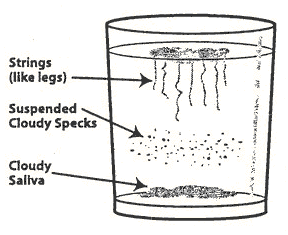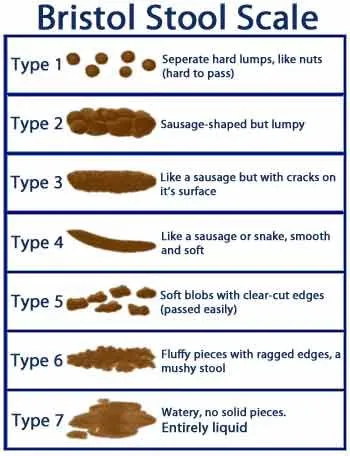Self Tests

Self Test 1 - My Diet
Candida Albicans & Yeast Infection Self Exams
First, let us say there is nothing inherently wrong with any of the above foods. Everyone enjoys a treat every now and then. However, if you find yourself eating these kinds of foods several times a week, much less every day or several times a day, then it definitely indicates trouble. That “sweet tooth” could indicate a deeper underlying health problem like Candida Albicans yeast infection Overgrowth.
With the exception of fruit, most of the items above are not even real foods. They are packaged, processed, refined and lifeless. They are loaded with sugar. If you are craving sugar (and you are if you eat these types of foods) then the chances are high that you are feeding the yeastie beastie.
Self Test 2 - My Body Fluids
We know this is NOT an accurate scientific test BUT it IS a real INDICATION of the density of your fluids which can harbor micro organisms and possible be a symptom of irritable bowel syndrome.
You heard it right – – this is a spit test.
The best time to do this test is the first thing in the morning as soon as you wake up. Before you rinse, spit, or put anything in your mouth, go get a glass of water (in a clear glass). Now build up a bunch of saliva (just mouth saliva, do not cough up anything) and spit it into the glass of water. Observe what happens.
The saliva will float. That is OK and normal. If within 15 minutes you see thin projections extending downward into the water, it is a positive sign for candida. The projections may look like hair, or small strings, like a jelly fish or spider legs, moving down into the water from the saliva floating on the top. Other positive indications might be very “cloudy” saliva that will sink to the bottom of the glass within a few minutes or particles that slowly sink or suspend below the saliva glob. What you are seeing are colonies of yeast which band together to form the strings.

Digestive Trouble
Bad Breath
Gas/Bloating
Indigestion
Diarrhea
Constipation
Intestinal Pain
Low Blood Sugar
Food/sugar cravings
Mouth or stomach ulcers
Allergies (Air or Food)
Food Sensitivities
Heartburn
Dry Mouth
Receding Gums
Hemorrhoids, rectal itch
Irritable bowel
Behavioral
Anti-social Behavior
Suicidal Tendencies
Insomnia
Depression
Irritability
Anxiety, high strung
Skin & Joint Problem
Thrush, Diaper Rash
Acne, Skin Rash, or Hives
Dry Skin & Itching
Finger, toe, or Foot Fungus
Athlete’s Foot
Liver Spots
Water Retention
Joint Pain
Muscle Aches
Numbness
Attention Troubles
Hyperactivity
Attention Deficit Disorder
Lack of Impulse Control
Female Problems
Infertility
Vaginal Yeast Infection
Menstrual Problems
PMS Symptoms
Bladder Infections
Endometriosis
No Sex Drive
Hormonal Imbalance
Iron Deficiency
Mental & Emotional
Dizziness,
Mental Fogginess, (Confused, spaced-out, blank stares, daydreaming)
Inability to Concentrate (Having to re-read the same thing twice)
Poor memory (Where are my car keys? or, Why did I come into this room?)
Mood Swings,
Headaches
Immune Problems
Lethargic/Laziness
Chronic Fatigue
Asthma, Hay Fever
Colds & Flu
Puffy Eyes
Respiratory Problems
Chemical Sensitivity
Epstein Barr Virus
Adrenal/Thyroid Failure
Cold/Shaky
Ear Infections
Chronic sore throat
Post nasal drip
Hair Loss
Stuffed sinus (sinusitis)
Overweight
Underweight
Diabetes
Burning Eyes
Premature Aging
Autism
Self Test 3 - Checklist for My Symptoms
This test is reviewing the signs and symptoms to determine if you have Candida Albicans yeast infection Overgrowth.
Candida Albicans yeast infection Overgrowth, Candida Overgrowth (CO) symptoms are so numerous and seemingly unrelated that they can be confusing to both doctor and patient. The majority of people who have CO do not realize they have it until they become seriously ill. Why? Because candida yeast not only steals nutrients from the food that you eat, it then poisons the tissues with waste material containing over 75 known toxins. Candida albicans is linked, directly or indirectly, to the following list of conditions and symptoms. A “symptom” is an outward sign that points to a deeper problem.
Review the 80 likely symptoms listed to the right to see if any apply to you. Give yourself ONE POINT for each of those which you have had persistently (for a month or longer, either currently or at anytime in the past).
0-4 points – Indicates variations of normal living (unless persistent and severe).
5-9 Points – Indicates a Clear Pattern shows likely development of CO dysbiosis.
10 or more – Indicates Strong Pattern and almost certain CO dysbiosis.
Self Test 4 - Stool
This test allows you to understand what causes loose or hard stools as well as the differences.
CONSTIPATION (tight, stagnant)
Type 1: Separate hard lumps, like nuts (hard to pass)
Type 2: Sausage-shaped, but lumpy
NORMAL HEALTHY
Type 3: Sausage/banana-like but with cracks on its surface
Type 4: BEST is Sausage/banana/snake-like, smooth and soft
DIARRHEA (trending loose)
Type 5: Soft blobs with clear cut edges (passed easily)
Type 6: Fluffy pieces with ragged edges, mushy, pudding-like
Type 7: Watery, no solid pieces, or entirely liquid.
The Bristol Stool Form Scale or Bristol Stool Chart is a seven group classification of the form that appears upon defecation of human feces. It was developed by Dr. K. Hering at the University of Bristol and was first published in the Scandinavian Journal of Gastroenterology in 1997.1. The form of the stool depends on the time it spends in the colon. Although not an exact science, the scale is used to help a physician recognize stool patterns for the purpose of diagnosing digestive conditions and as a research tool to evaluate the effectiveness of treatments for various diseases of the bowel, as well as a clinical communication aid.


